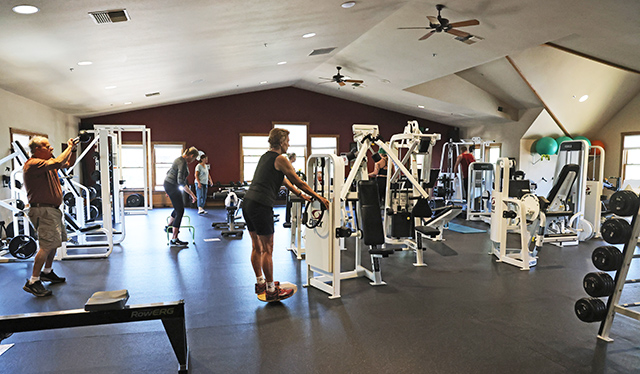Saggy jowls?
Published 4:00 am Wednesday, December 29, 2010

- Dr. Matthew White, a facial plastic surgeon at New York University Langone Medical Center, uses a new skin-tightening technique called Ulthera in New York on Dec. 16.
Necks don’t lie. Sagging there betrays age like the rings on a tree, and now-common Botox and fillers in the face make neck imperfections stand out in stark relief. In her 2006 best-seller, “I Feel Bad About My Neck,” Nora Ephron, by then 65 and a resolved turtleneck wearer, raged against the injustice of having no remedy for her slackening throat skin, short of surgery.
But it turns out that isn’t true. These days, less-invasive options exist to improve the appearance of one’s neck, provided it isn’t a full-blown turkey wattle. Like a romance, a neck can go wrong in many ways. Weight gain or genetics may lead to a double chin. Loose skin can be compounded by underlying lax muscle. A neck-lift (on its own or with a face lift) remains the best bet for a striking, lasting fix.
But careful liposuctioning of excess fat can also help streamline the full necked, especially those who still have relatively youthful elastic skin that can bounce back after the procedure. The trick is not to get suctioned to the point of looking skeletal (one should watch for underlying loose bands of muscle, which will become more obvious afterward).
If the issue is these isolated bands, injecting Botox into the neck muscle can make them less conspicuous in a patient with great skin tone, said Dr. Rod Rohrich, the chairman of the plastic surgery department at the University of Texas Southwestern Medical Center in Dallas. But the fix lasts only three to four months.
Promoted during the last year on “The Rachael Ray Show,” Ulthera is a new skin-lifting procedure that uses focused ultrasound to spur collagen growth deep under the epidermis. A single treatment may improve the contours of under-chin laxity in patients roughly 40 to 55 years old who feel they aren’t ready for surgery or amenable to it, several doctors said, including Dr. Matthew White, a facial plastic surgeon at NYU Langone Medical Center. The Ulthera handpiece pressed to a patient’s skin allows doctors to see underlying layers on a screen (as with gynecological ultrasounds) before they start the treatment, a first for noninvasive dermatological procedures. “We deposit energy to a precise depth below the surface of the skin without affecting the intervening tissue,” said Matthew Likens, the chief executive of Ulthera, the Mesa, Ariz., company behind it.
Patients may feel pain during treatment. Prospective candidates should also be aware that peer-reviewed published studies have yet to quantify just how much tightening can be expected in the neck and lower face. “That’s true,” Likens confirmed. (Such research is continuing, he said.)
That didn’t stop Dr. Mehmet Oz, a cardiologist, from proclaiming on his television show last month that Ulthera was a “revolutionary nonsurgical face lift” and promising to get rid of a viewer’s sagging neck live onstage. In the segment, Dr. Haideh Hirmand, a plastic surgeon in New York, said it was the first time she was “really excited” about a noninvasive technology for tissue-lifting. She emphasized that Ulthera is no substitute for surgery, if neck skin is too loose.
“The company will tell you it doesn’t hurt — it does,” said Dr. Tina Alster, a dermatologist in Washington, who has made a pain and an anti-anxiety drug mandatory for her Ulthera patients. That said, Alster, who will get a research stipend from Ulthera to study the device’s effect on off-face areas, is seeing results in the eyebrow area, cheeks and necks of middle-aged patients.
The “Dr. Oz” segment left the impression that the Ulthera device has been cleared by the Food and Drug Administration to be used for the neck and lower face as well as for the eyebrow area.
Not so. “The company can only promote the device for eyebrow-lift,” although the treatment regimen included cheeks and neck, too, Karen Riley, a spokeswoman for the agency, wrote in an e-mail. “But they can make no claims regarding these areas and cannot promote their device for treating specific conditions within these areas.”
Happy with results
Nina Meyerhof, who runs Children of the Earth, a peace organization, was willing to chance it when she met with White this month for Ulthera to firm up her neck and jawline. “I wanted everything to look fresh and tight,” she said.
At 68, Meyerhof, of South Burlington, Vt., is a decade or two older than White’s typical candidate, someone who is just starting to notice under-chin skin laxity. But White, who has researched focused ultrasound, felt her skin was still so elastic that it would tighten.
Ulthera’s results take a few months to appear, since creating collagen takes time. But Meyerhof, who felt discomfort along her jaw during the procedure, said the slight hanging bit under her chin no longer sags, and her face is “tighter around the jawline.”
Likens, of Ulthera, said patients can expect results to last “a year or longer.” But the peer-reviewed clinical trial of 35 patients submitted to the FDA tracked patients for only 90 days.
Meyerhof is thrilled with her results but said she would remain so only if they last. “I feel like I paid a whole lot of money for it,” she said, declining to disclose how much. (Ulthera can cost $1,000 to $4,000 depending on areas treated.) But she put it this way: “If it only works for a year, I will not be happy. I took that gamble.”
Minimal tightening
Many doctors won’t offer Ulthera until more research is done. Rohrich, the editor of the journal Plastic and Reconstructive Surgery, said he can’t always differentiate between the photographs of the neck taken before and after the Ulthera. The tightening is “very minimal,” he said, adding that long-term multicenter studies are needed. “Hope springs eternal, and hope springs incredible revenue based on hype,” he said.
Many people who “hate” their necks conclude that tightening the neck requires tightening the face, since, as Ephron put it, “it’s all one big ball of wax.”
Not necessarily. Granted, “all necks are difficult,” and it’s the hardest part of a face-lift, said Dr. James Stuzin, a plastic surgeon in Miami.
But he and some other surgeons have long offered a so-called “isolated neck-lift.” Some surgeons don’t do neck-lifts, since patients might return complaining that they cannot live with their imperfect jowls once their neck is tight.
Perhaps surprisingly, men get more isolated neck-lifts than women, plastic surgeons say. “Usually with women, they are getting a face- and neck-lift,” said Dr. Felmont Eaves, the president of the American Society for Aesthetic Plastic Surgery, who practices in Charlotte, N.C. “In men, we don’t have exact statistics, but it’s pretty common to see them come in just for the neck.”
After a 50th reunion for business school made him “very neck-conscious,” Douglas Weil, 74, signed up for an isolated neck-lift in November with Dr. William Y. Hoffman, the chief of the plastic surgery division at the University of California, San Francisco. “It was one of the last things I ever thought I’d do,” Weil said, adding he hasn’t thought twice about his baldness. But now he’s thrilled with his sleek neckline, he said, and even told his rabbi about the surgery.
The rabbi’s retort? “What men do to please their women!”






